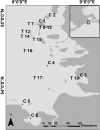Time and tide: Seasonal, diel and tidal rhythms in Wadden Sea Harbour porpoises (Phocoena phocoena)
- PMID: 30893334
- PMCID: PMC6426179
- DOI: 10.1371/journal.pone.0213348
Time and tide: Seasonal, diel and tidal rhythms in Wadden Sea Harbour porpoises (Phocoena phocoena)
Abstract
Odontocetes have evolved a rich diversity of prey- and habitat-specific foraging strategies, which allows them to feed opportunistically on locally and temporally abundant prey. While habitat-specific foraging strategies have been documented for some odontocete species, this is less known for the harbour porpoise (Phocoena phocoena). We collected multiple years of acoustic data using echolocation click loggers to analyse porpoise occurrence and buzzing behaviour, indicating feeding, in the German Wadden Sea (North Sea). Seasonal, diel and tidal effects were studied using Generalised Estimating Equations (GEE-GAMs). Locally season, time of day and tidal time significantly influenced the probability of porpoise detections and detection of foraging sequences (buzzes). Hunting strategies, and therefore frequency of buzzes, were likely affected by prey distribution and large differences between POD locations indicated that porpoises used highly specific behaviour adapted to tide and time of day to efficiently feed on the available prey. Strong seasonal and spatial variation in diel and tidal effects underline the importance of long-term observations. Studies on porpoise behaviour are often based on short-term observations and might rather reflect a seasonal than a general pattern. The results of this study show clearly that significant changes in porpoise behaviour can be found in short and long-term observations. Here some features are based on short term determinants and others are stable over years and care should be taken about drawing general conclusions based on local patterns. Highly variable spatio-temporal patterns indicate a high flexibility of porpoises in a highly variable environment and address a challenge for complex conservation management plans.
Conflict of interest statement
The authors have declared that no competing interest exist.
Figures






References
-
- MacArthur RH & Pianka E (1966). On optimal use of a patchy environment. Am. Nat. 100:603–609
-
- Werner EE & Hall DJ (1974). Optimal Foraging and the Size Selection of Prey by the Bluegill Sunfish (Lepomis macrochirus). Ecology. 55 (5):1042
-
- Koopman HN (1998) Topographical distribution of the blubber of harbor porpoises (Phocoena phocoena). J Mammal 79: 260−270
-
- Hoekendijk JP, Spitz J, Read AJ, Leopold MF, Fontaine MC (2018), Resilience of harbor porpoises to anthropogenic disturbance: Must they really feed continuously?. Mar Mam Sci 34:258–264
Publication types
MeSH terms
LinkOut - more resources
Full Text Sources

